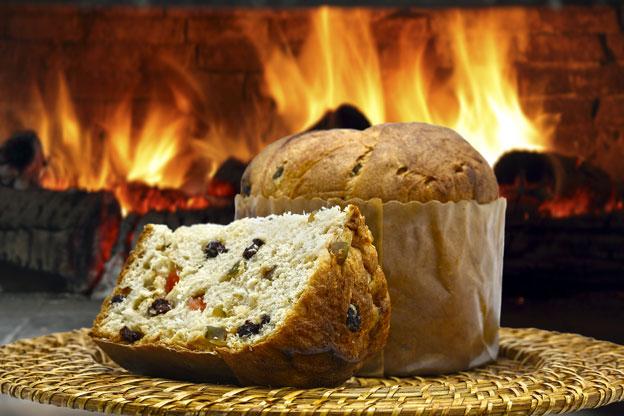At Christmas, Americans enjoy pumpkin pie, the English have plum or Christmas pudding and the Italians have panettone. Just the mention of this sweet Milanese bread conjures up the aromas of citrus, vanilla, and candied fruit.
This staple of Italian festivities dates back as far as the Middle Ages when to celebrate Christmas, people would replace their daily bread with a richer recipe, a practice clearly documented in a 15th-century manuscript written by George Valagussa, one of the Sforza family’s tutors; however, many legends have grown up around the origin of Panettone.
The popular legend is that of a nobleman and falconer named Ughetto, who fell in love with Adalgisa, the daughter of a baker whose business had hit upon hard times. Ughetto’s family were unhappy with his choice and forbade him to marry such a lowly girl. In a bid to continue seeing his lover, Ughetto in disguise took a job at the bakery where one day after selling some of his falcons, he purchased butter and sugar and added it to the bakery’s bread mix. Ughetto’s sweet bread became popular and the ailing bakery soon began to see better times, which pleased Adalgisa. To continue pleasing her, one day near Christmas, he added candied peel and raisins to the mix and the popularity of his bread surpassed everything the bakery had ever produced before - in fact it became so popular that his family relented and gave their permission for the couple to marry.
A traditional panettone loaf is cylindrical in shape with a cupola (domed) top. It should always be taller than it is wide, with a soft and airy interior beneath a dark exterior. Modern versions are now available with the fruit being replaced by chocolate, however traditionally it should be citrus flavoured fruit bread.

How you eat your panettone is entirely up to personal choice. Some Italians will have it with coffee in the morning, while others prefer it as a mid-day treat with a glass of Marsala wine and then, there’s those who choose to have theirs after dinner as dolce with a good sparkling Moscato.
The second legend has to do with the name itself, panettone, which would literally translate in English as ‘bread of Toni.’ The actual translation is ‘big bread,’ from ‘panetto’ meaning dough and the suffix ‘one’ meaning large.
It is said that at the 15th century court of Duke Ludovico, during a Christmas celebration, the chef burned the dessert. When the Duke demanded that dessert be served, the chef became visibly distressed and, seeing this, a scullery boy named Toni approached him and explained that he’d made a sweet loaf out of left-overs and offered this bread to the chef who accepted and served it at court. The dessert was a success and the Duke called the chef to congratulate him in front of his guests, however, unable to take the credit, the chef told everyone who had really made the bread and that’s how it became known as panettone; the bread of the scullery boy, Toni.
Panettone is seen by the Italians as an acceptable gift to take when visiting someone over the festive period and therefore, from the middle of November, Italian supermarkets and stores start to display the commercially made loaves. Packed in elaborately decorated boxes festooned with ribbons, this simple bread can command quite a high price. Very few Italians will make their own panettone, choosing to buy a ready-made loaf, however the internet offers plenty of recipes, ranging from the traditional to celebrity variations, so making it at home isn’t beyond the reach of most competent home-bakers.

The third legend has a less romantic story claiming that the sweet bread wasn’t created by Signor Ughetto, but by Sister Ughetta, a nun that wanted to please her fellow holy sisters one Christmas. The tale tells of a convent where the prospect of Christmas did little to lift the spirits of its poor and miserable nuns. One day while in the kitchen, it is said that Sister Ughetta fashioned a cake out of kindness for her fellow sisters and added fruit and peel and before baking she took a knife and cut a crucifix shape in its top. Once cooked, the cuts left by the knife opened up in the cupola crust making the cake a pleasing addition to an otherwise meagre festive feast for the holy sisters.
The traditional way of serving panettone is simply remove the paper liner and slice the loaf with a serrated knife as you would a cake, to get triangular wedges. A word of warning though, whichever way you choose to serve your panettone: it’s worth noting that Italians consider it bad luck to remove the domed top and to consume it on your own.













